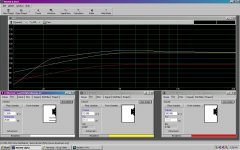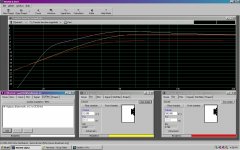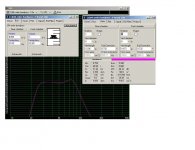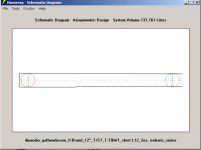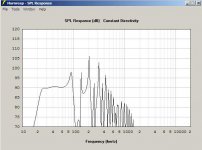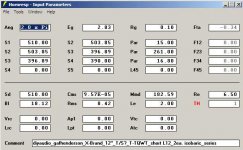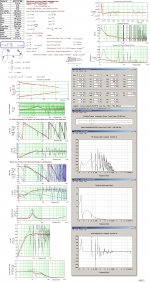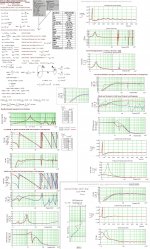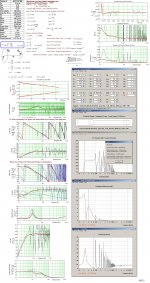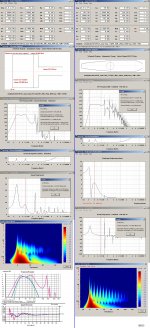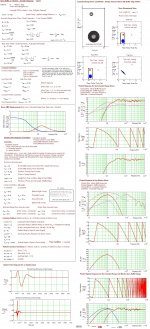ESP - The Linkwitz Transform Circuit
You can buy the circuit board and parts reasonably cheaply, and this system ought to give reasonable low frequency extension and SPL from a fairly small box. You're going to need a decent amount of amplification, though.
You can buy the circuit board and parts reasonably cheaply, and this system ought to give reasonable low frequency extension and SPL from a fairly small box. You're going to need a decent amount of amplification, though.
ESP - The Linkwitz Transform Circuit
You can buy the circuit board and parts reasonably cheaply, and this system ought to give reasonable low frequency extension and SPL from a fairly small box. You're going to need a decent amount of amplification, though.
not sure the extra ooomph from the amplifier can be provided just now, so that's perhaps an experiment to be done once i feel competent enough to deal with my own amplifier + power supply set ups for the task.
Hi gafhenderson,
Measure the Thiele / Small parameters of your drivers, it is not hard to do:
Measuring Loudspeaker Driver Parameters
Then mount the drivers face-to-face (clamshell style), and measure the T/S parameters of the isobaric configuration.
At least you'll have a starting point.
Regards,
Measure the Thiele / Small parameters of your drivers, it is not hard to do:
Measuring Loudspeaker Driver Parameters
Then mount the drivers face-to-face (clamshell style), and measure the T/S parameters of the isobaric configuration.
At least you'll have a starting point.
Regards,
Hi gafhenderson,
Measure the Thiele / Small parameters of your drivers, it is not hard to do:
Measuring Loudspeaker Driver Parameters
Then mount the drivers face-to-face (clamshell style), and measure the T/S parameters of the isobaric configuration.
At least you'll have a starting point.
Regards,
is this required because i think bjorno has found the correct driver himself? after looking it up it looks the same.
Hi gafhenderson,
I assume, that bjorno just referred to a generic "...crap Car driver..." in Post #4, and to a specific "...crap Car driver..." in Post #15.
Your drivers from Post #1 seem to be best suited to a sealed box, size anything for 50 to 500 L, stuff liberally. For best cancellation of magnetic and mechanical irregularities use the clamshell or the attached arrangement.
For anything else you'll need the correct T/S parameters.
Regards,
I assume, that bjorno just referred to a generic "...crap Car driver..." in Post #4, and to a specific "...crap Car driver..." in Post #15.
Your drivers from Post #1 seem to be best suited to a sealed box, size anything for 50 to 500 L, stuff liberally. For best cancellation of magnetic and mechanical irregularities use the clamshell or the attached arrangement.
For anything else you'll need the correct T/S parameters.
Regards,
Attachments
Hi gafhenderson,
I assume, that bjorno just referred to a generic "...crap Car driver..." in Post #4, and to a specific "...crap Car driver..." in Post #15.
Your drivers from Post #1 seem to be best suited to a sealed box, size anything for 50 to 500 L, stuff liberally. For best cancellation of magnetic and mechanical irregularities use the clamshell or the attached arrangement.
For anything else you'll need the correct T/S parameters.
Regards,
he listed an audiobahn driver (which fits the crappy car driver) but once i followed the parts number he used the driver shown on the audiobahn website showed something pretty identical to what i have. what other parameters do i need other than those originally provided in my first post?
fs: 37.4hz
qms: 5.28
qes: 0.88
qts: 0.76
Vas: 69
thanks for the pdf info.
Hi gaf henderson,
Sd=active area of cone (measure diameter from about center of surround to center of surround, and calculate); guess: Sd=510cm^2.
Re=drive DC resistance (measure); guess: 3.25 Ohm for a Z_nom=4 Ohm
From that Hornresp and WinISP can calculate the necessary other parameters.
Regards,
Sd=active area of cone (measure diameter from about center of surround to center of surround, and calculate); guess: Sd=510cm^2.
Re=drive DC resistance (measure); guess: 3.25 Ohm for a Z_nom=4 Ohm
From that Hornresp and WinISP can calculate the necessary other parameters.
Regards,
could you post the outputs of what you modelled so i can see what it looks like compared to what others posted as some of the graphs didn't look so bad in ported and sealed boxes. imagine it was a lot better then my last subwoofer experience. a little 8 inch ported eltax thing that sounded like an asthmatic hitting a drum wheeze thud wheeze thud thud pop wheeze.
ok, I extrapolated the missing TS parameters using hornresp and BBP so these are just guesses. All the graphs are two drivers in parallel for a 4ohm load using 100w. The red line is modeled as isobaric to show the difference from standard in efficiency but if the two drivers were used normally the red line would be the same just +3db.
Surprisingly the infinite baffle model was the best. (that's the red line)
Attachments
Hi,
Discard the picture in post#4 as containing an apples to orange comparison.
The HR simulation uses 4 drivers ,i.e. two separate isobaric configurations but the MJK only one. =
A new corrected picture: The first one of the submitted.
b 🙂
Discard the picture in post#4 as containing an apples to orange comparison.
The HR simulation uses 4 drivers ,i.e. two separate isobaric configurations but the MJK only one. =

A new corrected picture: The first one of the submitted.
b 🙂
Attachments
Hi,
Here is my try at this driver in WinISD: BP6 Isobaric. Would you cut wood from this level of data?
Regards,
gotta start somewhere really. just got to decide where to go for the initial plunge.
ok, I extrapolated the missing TS parameters using hornresp and BBP so these are just guesses. All the graphs are two drivers in parallel for a 4ohm load using 100w. The red line is modeled as isobaric to show the difference from standard in efficiency but if the two drivers were used normally the red line would be the same just +3db.
Surprisingly the infinite baffle model was the best. (that's the red line)
guess that'd be its automotive heritage showing through? tbh they didn't look as bad as i was expecting. what are the down sides to open baffle apart from the lack of driver protection? makes construction fairly easy, but what about room placement?
gafhenderson
Originally Posted by tb46 View Post
Hi,
Here is my try at this driver in WinISD: BP6 Isobaric. Would you cut wood from this level of data?
Regards,
gotta start somewhere really. just got to decide where to go for the initial plunge.
Quote:
Originally Posted by revboden View Post
ok, I extrapolated the missing TS parameters using hornresp and BBP so these are just guesses. All the graphs are two drivers in parallel for a 4ohm load using 100w. The red line is modeled as isobaric to show the difference from standard in efficiency but if the two drivers were used normally the red line would be the same just +3db.
Surprisingly the infinite baffle model was the best. (that's the red line)
guess that'd be its automotive heritage showing through? tbh they didn't look as bad as i was expecting. what are the down sides to open baffle apart from the lack of driver protection? makes construction fairly easy, but what about room placement?
Hi,
IB (Infinity Baffle) would be a good idea if you mount your drivers in-wall and ensure a large rear volume.. but also an OB (Open Baffle) system might be an application to consider:
b🙂
Attachments
- Status
- Not open for further replies.
- Home
- Loudspeakers
- Subwoofers
- 'isobaric' schooling help please.
